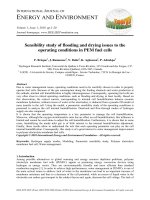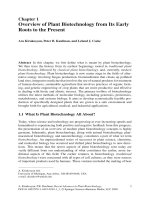- Trang chủ >>
- Khoa Học Tự Nhiên >>
- Vật lý
down to the wire confronting climate collapse sep 2009
Bạn đang xem bản rút gọn của tài liệu. Xem và tải ngay bản đầy đủ của tài liệu tại đây (1.11 MB, 284 trang )
Down to the Wire
Other Books by David W. Orr
Ecological Literacy (1992)
Earth in Mind (1994/2004)
The Nature of Design (2002)
The Last Refuge (2004)
Design on the Edge (2006)
The Global Predicament,
coedited with Marvin S. Soroos (1979)
The Campus and Environmental Responsibility,
coedited with David G. Eagan (1992)
The Sage Handbook of Environment and Society,
coedited with Jules Pretty et al. (2008)
DAVID W. ORR
Down to the
Wire
Confronting Climate
Collapse
z
1
2009
1
Oxford University Press, Inc., publishes works that further
Oxford University’s objective of excellence
in research, scholarship, and education.
Oxford New York
Auckland Cape Town Dar es Salaam Hong Kong Karachi
Kuala Lumpur Madrid Melbourne Mexico City Nairobi
New Delhi Shanghai Taipei Toronto
With offi ces in
Argentina Austria Brazil Chile Czech Republic France Greece
Guatemala Hungary Italy Japan Poland Portugal Singapore
South Korea Switzerland Thailand Turkey Ukraine Vietnam
Copyright © 2009 by Oxford University Press, Inc.
Published by Oxford University Press, Inc.
198 Madison Avenue, New York, NY 10016
www.oup.com
Oxford is a registered trademark of Oxford University Press
All rights reserved. No part of this publication may be reproduced,
stored in a retrieval system, or transmitted, in any form or by any means,
electronic, mechanical, photocopying, recording, or otherwise,
without the prior permission of Oxford University Press.
Library of Congress Cataloging-in-Publication Data
Orr, David W., 1944–
Down to the wire : confronting climate collapse / David W. Orr.
p. cm.
Includes bibliographical references and index.
ISBN 978-0-19-539353-8
1. Climatic changes. 2. Climatic changes—Environmental aspects.
I. Title.
QC981.8.C5O77 2009
363.34—dc22 2009005584
987654321
Printed in the United States of America
on acid-free paper
For my grandchildren Lewis, Molly, Ruby Kate,
and Margaret Eloise.
This page intentionally left blank
Preface ix
Acknowledgments xix
Introduction 1
PART I POLITICS AND GOVERNANCE
Chapter 1 Governance 13
Chapter 2 Late-Night Thoughts about Democracy
in the Long Emergency 49
Chapter 3 Leadership in the Long Emergency 84
PART II CONNECTIONS
Chapter 4 The Carbon Connection 111
Chapter 5 The Spirit of Connection 126
Contents
S
viii
contents
PART III FARTHER HORIZONS
Chapter 6 Millennial Hope 155
Chapter 7 Hope at the End of Our Tether 181
Chapter 8 The Upshot: What Is to Be Done? 203
Postscript: A Disclosure 216
Notes 221
Sources 229
Index 249
The ongoing disruption of the Earth’s climate by man-made green-
house gases is already well beyond dangerous and is careening toward
completely unmanageable.
—John Holdren
All of us breathe from the same atmosphere, drink
the same waters, and are fed from the land. All of us depend, more
than we can know, on the stability of the same biogeochemi-
cal cycles, including the movement of carbon from plants to the
atmosphere, oceans, soils, and living creatures. All of us are vulner-
able to the remorseless workings of the large numbers that govern
Earth systems. All of us are stitched to a common fabric of life,
kin to all other life forms. All of us are products of the same evo-
lutionary forces and carry the marks of our long journey in time.
Each of us is a small part of a common story that began three bil-
lion years ago. We are all made of stuff that was once part of stars,
and we will all become dust to be remade someday into other life
forms. As persons, we are visitors on the Earth for only a brief
Preface
z
S
x
preface
moment. As a species, however, we are in our adolescence, and as
is common at that stage of life we live dangerously. Specifi cally,
we have created three ways to commit suicide: by nuclear anni-
hilation, by ecological degradation, and, as computer scientist Bill
Joy notes, by the consequences of our own cleverness—eviction
by technologies that can self-replicate and might one day fi nd
Homo sapiens useless and inconvenient.
1
We have entered an era
that Harvard biologist Edward O. Wilson calls “the bottleneck”
(Wilson, 2002, p p. 22–41).
This book is written in the belief that we will come through
that gauntlet chastened but improved. But it will be trial by fi re,
hopefully, a tempering process in which we will shed our illu-
sions of being separate from nature and our pretense that we can
master nature or each other through violence. On the other side
of the bottleneck, maybe we will have gained a clearer vision of
the value of life and a deeper understanding of what it means to
be stewards and trustees for all life to come. But this is certainly
not the only scenario one might imagine—perhaps, it is not even
very likely. There are darker possibilities with which we must
contend and which we must have the foresight to anticipate and
the wisdom to avoid.
In the fossil fuel age we lived in the unspoken faith that there
are no “booby traps for unwary species,” as biologist Robert Sin-
sheimer once put it. Unwittingly we set our own, and now the
carbon trap is nearly sprung. Even before the coal and oil age we
exploited carbon-rich soils and forests, and that is the history of
rising and falling empires and the uneven march of civilization.
The trap was founded on ignorance of our impact on the bio-
geochemical cycles of Earth, which posed no serious problems
when we were fewer and depended on sunlight and wind for
our energy. But now the six and a half billion of us, soon perhaps
to be eight or nine billion, are living carbon-intensive lives. We
set the trap and it will now take our most creative and sustained
efforts to avert catastrophe, and that will require reducing our
preface
S
xi
carbon footprint from 22 tons per person per year to 1–2 tons or
even less. But even then, “when this centuries-long climate storm
subsides, it will leave behind a new, warmer climate state that will
persist for thousands of years. That’s the basic outlook” (Archer,
2009, p. 45).
Even in the near term it is already too late, however, to avert
signifi cant disasters, and that is a diffi cult message to convey with-
out inducing paralysis or denial even among those willing to lis-
ten. It is a great deal easier for all of us to hit the snooze button
on the alarm clock, go back to sleep, and hope that it all goes
away, or to pretend that dire circumstances present only opportu-
nities. Climate change presents opportunities for some, certainly,
but for the Tuvalu islanders, the victims of fl oods and droughts
and of larger hurricanes and typhoons, those living in low-lying
areas like Bangladesh, and the 150,000 who die each year in cli-
mate change–driven weather events, the word “opportunity” has
a peculiarly hollow sound. It will as well for the 250,000,000 or
more climate refugees that the United Nations estimates will be
homeless by midcentury.
Through the coming decades and centuries of the bottle-
neck, great leadership at all levels will be essential. We will need
leaders fi rst, with the courage to help the public understand and
face what will be increasingly diffi cult circumstances. The pri-
mary cause is climate destabilization, described in four consensus
reports by the Intergovernmental Panel on Climate Change over
20 years and hundreds of other scientifi c reports. Often, however,
we dismiss bearers of bad news or inconvenient truths until the
point of crisis, when reality can no longer be evaded. The mythi-
cal fi gure of Cassandra and the Old Testament prophet Jeremiah
were fated to be ignored until it was too late to avoid the dire
things they foretold. The same disbelief has greeted the increas-
ingly frequent and rigorous warnings in our time. One of the
earliest, for example, was issued by the Council on Environmental
Quality in the Carter administration and published in 1980 as the
S
xii
preface
Global 2000 Report (Barney, 1980). The authors catalogued in great
detail the scientifi c evidence about declining ecosystems, climate
change, and species loss, along with measures necessary to move
the country toward sustainability. But we chose to evade reality
and sought refuge in the slogan that it was “morning in America
again.” Three decades later it is twilight, and we live with the
ecological, economic, political, and social consequences of our
own making.
Second, in the “long emergency”
2
ahead leaders will need an
uncommon clarity about our best economic and energy options.
Some choices being proposed by well-funded and highly orga-
nized lobbies would commit the nation and the world to courses
of action that will lead to unfortunate and irreversible conse-
quences. They will need to understand their relative costs, risks,
and benefi ts, including those over the long term, to avoid making
decisions that lock us in to policies that we—or our children—
will someday sorely regret. There are better possibilities that
would go a long way toward solving the underlying causes of our
problems. But knowing which is which requires that they recog-
nize the difference between the structure of problems and their
coeffi cients—the rate at which they get worse. In other words,
they need to understand the difference between Band-Aids and
authentic cures, and that requires that we better understand other-
wise obscure concepts like feedback loops, leads, and lags, which is
to say how the world works as a unifi ed system (Meadows, 2008).
They must see, in other words, the many connections between
climate, environment, prosperity, security, and fairness. In this per-
spective, climate destabilization is not an aberration but a predict-
able outcome of a system haphazardly created in the dim light of
a dangerously incomplete image of reality.
The results are increasingly clear: even were we to stop emit-
ting heat-trapping gases quickly, we will still experience centu-
ries of bigger storms, larger and more frequent fl oods, massive
heat waves, and prolonged drought, along with rising sea levels,
preface
S
xiii
disappearing species, changing diseases, decline of oceans, and
radically altered ecosystems.
3
In the long emergency ahead, people,
communities, societies, institutions, organizations, and global soci-
ety will be sorely stressed. The third quality of leadership in these
circumstances is the capacity to foster a vision of a humane and
decent future. Such a future will require a great deal of kind-
ness for growing numbers of people who will need our help as
friends, neighbors, community members, and fellow sojourners
on this fragile craft that we call civilization. Eventually, we will
need their help as well. No one will remain unaffected by climate
destabilization and its many consequences that will spill across the
boundaries of geography, circumstance, and time.
The news about climate, oceans, species, and all of the col-
lateral human consequences will get a great deal worse for a long
time before it gets better. The reasons for authentic hope are on a
farther horizon, centuries ahead when we have managed to stabi-
lize the carbon cycle and reduce carbon levels close to their prein-
dustrial levels, stopped the hemorrhaging of life on Earth, restored
the chemical balance of the oceans, and created governments and
economies calibrated to the realities of the biosphere and to the
diminished ecologies of the postcarbon world. The change in our
perspective from the nearer to the longer term is, I think, the most
diffi cult challenge we will face. We have become a culture predi-
cated on fast results, quick payoffs, and instant gratifi cation. But
now we will have to summon the fortitude necessary to under-
take a longer and more arduous journey. Rather like the builders
of the great cathedrals of Europe, we will need stamina and faith
to work knowing that we will not live to see the results.
I begin by assuming the most optimistic outcome possible—
that, by a combination of advanced technology and wise policy
choices, the world will quickly act to stabilize concentrations of
greenhouse gases and reduce emissions to a level below that which
would lead to runaway climate change. Nonetheless, barring some
quite unexpected technological breakthrough, the consequences
S
xiv
preface
of what we have already “bought” will still cause great hardship
everywhere. Glib talk about “climate solutions” misleads by con-
veying the impression that climate is merely a problem that can
be quickly solved by technological fi xes without addressing the
larger structure of ideas, philosophies, assumptions, and paradigms
that have brought us to the brink of irreversible disaster. The
point is the same as one that has been attributed to Einstein: “sig-
nifi cant problems we face cannot be solved at the same level of
thinking we were at when we created them” (Calaprice, 2005,
p. 292). There are certainly better technologies to be deployed,
and far better ones soon to come. But the climate is not likely
to be restabilized by any known technical fi x quickly, easily, or
painlessly. Rather, as geophysicist David Archer puts it:
The climatic impacts of releasing fossil fuel CO
2
to the atmo-
sphere will last longer than Stonehenge. Longer than time
capsules, longer than nuclear waste, far longer than the age of
civilization so far . . . [it] will persist for hundreds of thousands of
years into the future. (Archer, 2009, pp. 1, 90)
Climate change, in other words, is not so much a problem to be
fi xed but rather a steadily worsening condition with which we
must contend for a long time to come. Improved technology, at
best, will only reduce the scale of the problem and buy us time to
build the foundations for a more durable and decent civilization.
In the words of biologist Anthony Barnoski, “stabilizing [climate]
in this sense means global temperature staying more or less con-
stant for at least hundreds, probably thousands of years. In short,
as far as generations of humans are concerned, we probably never
will revert back to the ‘old’ climate” (2009, p. 29).
The few remaining climate skeptics aside, there are two general
positions that bear on my own views. The fi rst is the belief that
there is a rising tide of groups, associations, and nongovernmental
organizations forming around the world as a kind of planetary
immune system that will transform our politics, heal the widening
preface
S
xv
breach between humankind and the rest of nature, and lead on
to sunnier uplands. There is considerable evidence for what Paul
Hawken calls “blessed unrest.” Clearly something is astir in the
world, and perhaps it will eventually transform our manner of
living and relating to the world and to each other. But it has
not done so yet. In the meantime, carbon is accumulating in the
atmosphere faster than ever before while inequality, violence, eco-
nomic stress, and ecological degradation grow. How blessed unrest
amplifi ed by the Internet will fare in an increasingly destabilized
world is anyone’s guess, but to get through the bottleneck more or
less intact we will need lots more of it, well organized, creatively
applied, and allied with leadership in all sectors of society. But
there is no adequate substitute for better leadership at all levels,
including those who are engaged in the conduct of the public
business, which is to say politics.
A second view holds that we ought to focus only on solu-
tions, not problems and dilemmas. But the solutions most talked
about are technological and so neither require nor result in any
particular improvement in our behavior, politics, or economics
that brought us to our present situation in the fi rst place. And
neither do they call us to rethink the rationality of our underlying
motives and objectives or become aware of the political and social
choices hidden in our technologies (Winner, 1986, pp. 19–39).
The aim, merely, is to do what we are already doing more effi -
ciently and effectively without asking whether it is worth doing
at all. We ought, it is said, to make hope possible, not despair
plausible. I believe that to be a good rule until wishful thinking
masquerades as hope and avoidance of despair becomes evasion
of reality. Those who focus exclusively on solutions are rather like
doctors who only prescribe and never diagnose. In the real world
an effective prescription depends a great deal on an accurate diag-
nosis of the nature and source of the problem. After decades of
hyperconsumerism and worship of commerce, a dose of reality,
with or without despair, would lay the foundation for a more
S
xvi
preface
grounded, sober, and authentic hope. Our best chance of surviv-
ing through the long emergency ahead lies in our capacity to face
diffi cult facts squarely, think clearly about our possibilities, and get
down to work.
The faith placed in better technology is tied to the faith in
unfettered markets and commerce, the reputation of which had
been much improved due to the efforts of Milton Friedman and
his free-market disciples until the economic collapse of 2008. The
appeal to economic self-interest as the engine of human progress
has its origins in the writings of Adam Smith, and there is much
to be said on its behalf. Forgotten in the euphoria, however, are
Smith’s own misgivings about the results of unalloyed self-interest,
evident in both The Wealth of Nations and The Theory of Moral Sen-
timents. Until the great fi nancial implosion of 2008, amnesia also
veiled the spotty and often shabby record of corporations and
fi nancial institutions operating without the countervailing power
of alert governments and an engaged and sometimes enraged citi-
zenry. Economists, nonetheless, are inclined to attribute all societal
shortcomings to a failure of markets, and sometimes, in some ways,
they are. But the belief that climate destabilization represents “the
largest market failure in history” is misleading because it over-
looks a prior and larger failure of political leaders to acknowledge
the problem before it grew into a crisis. Even with ample and
increasingly urgent warnings, they failed to restructure the rules
and regulations that govern the use of fossil fuels when it would
have been relatively easy and cheap to minimize or avoid much of
the crisis altogether.
I write, accordingly, as an advocate for better leadership, an
improved democracy in the United States, and more creative and
competent management of the public business. Climate destabi-
lization is obviously a global crisis, but I’ve chosen to narrow my
focus to the United States because we are the largest economy on
Earth and the largest source of heat-trapping gases in the indus-
trial era, and we have greater leverage on the issue than any other
preface
S
xvii
country. And for no good reason we were absent without leave
until very recently on the largest issue ever on the human agenda.
The United States, in other words, is not just another country; it
is, rather, the linchpin in the effort to avoid catastrophic global
destabilization.
Finally, this book is a companion of sorts to a project launched
in June of 2006 at a Wingspread conference convened by Ray
Anderson, Bill Becker, and Jonathan Lash, members of President
Clinton’s Council on Sustainable Development, which had gone
dormant in the years of George W. Bush. Among the recommen-
dations from that conference was one I made to create a climate
action plan for the fi rst hundred days of the next U.S. president.
4
The idea was accepted and funded by Adam Joseph Lewis, the
Rockefeller Brothers Fund, and others. The project was cochaired
by Ray Anderson and Gary Hart and ably directed by Bill Becker.
The fi nal report, presented to John Podesta, director of the Obama
transition team, included some three hundred proposals across a
dozen categories ranging from transportation to land use. That
document was aimed at near-term specifi c policy changes—the
things the next U.S. president and the government would have
to do quickly to respond to the challenge of climate destabili-
zation. This book, by contrast, addresses the larger issues behind
the immediate policy choices and headlines. It is a meditation on
the leadership we will need to eventually surmount the largest
challenges we’ve ever experienced. My focus is what historian
James MacGregor Burns describes as transformational leadership
that recognizes “real need, the uncovering and exploiting of con-
tradictions among values and between values and practice, the
realigning of values, reorganization of institutions where neces-
sary, and the governance of change. Essentially the leader’s task is
consciousness-raising on a wide plane” (Burns, 1978, p. 43). And
we will need a great deal of consciousness-raising in the years
ahead.
This page intentionally left blank
This book owes much to the friendship, collaboration,
and counsel of many over many years and to others I have not
met but who have instructed through their example, writings, and
leadership. My thanks to John Adams, Paul Alsenus, Ray Ander-
son, Kenny Ausubel, Zenobia Barlow, Taylor Barnhill, Andy Bar-
nett, Seaton Baxter, David Beach, Bill Becker, Frances Beinecke,
Janine Benyus, Bob Berkebile, Scott Bernstein, Thomas Berry,
Wendell Berry, Rosina Bierbaum, Jessica Boehland, Nina Leo-
pold Bradley, Lester Brown, Peter Brown, Bill Browning, Peter
Buckley, Fritjof Capra, Majora Carter, Rick Clugston, Leila Con-
nors, Peter Corcoran, Tony Cortese, Bob Costanza, David Crock-
ett, Michael Crow, John Curry, Herman Daly, Leo DiCaprio,
Marcellino Echeverria, David Ehrenfeld, Jim Elder, John Elder,
Richard Falk, Chris Flavin, Karen Florini, Peter Forbes, Eric Frey-
fogle, Howard Frumkin, Ross Gelbspan, Larry Gibson, Marion
Gilliam, Teddy Goldsmith, Zac Goldsmith, Eban Goodstein, Al
Gore, John Grim, Maria Gunnoe, Bruce Hannon, Jim Hansen,
Gary Hart, Nick Hart-Williams, Paul Hawken, Denis Hays, Teresa
Heinz, Mary Anne Hitt, John Huey, Buddy Huffaker, Wes Jack-
son, Sadhu Johnston, Van Jones, Greg Kats, Steve Kellert, Julian
Acknowledgments
z
S
xx
acknowledgments
Keniry, Robert Kennedy, Bob Kerr, David Kline, Bob Koester,
Fred Krupp, Satish Kumar, Jeremy Leggett, Carl Leopold, Estella
Leopold, Adam Lewis, Gene Logsdon, Rich Louv, Tom Lovejoy,
Amory Lovins, Hunter Lovins, Wangari Maathai, Arjun Makhijani,
Ed Mazria, Carl McDaniel, Jay McDaniel, Bill McDonough, Bill
McKibben, Gary Meffe, George Monbiot, Bill Moomaw, Kath-
leen Dean Moore, Bill Moyers, Wil Orr, Jon Patz, Matt Peter-
son, Michael Pollan, Carl Pope, Jonathan Porritt, John Powers,
Jules Pretty, Steven Rockefeller, Kirk Sale, Chuck Savitt, Jonathan
Schell, Stephen Schneider, Larry Schweiger, Peter Senge, Nina
Simon, Robert Socolow, David Shi, Gus Speth, Paul Stamets,
Frederick Steiner, Steven Strong, Bill Sullivan, Woody Tasch, Bill
Thompson, John and Nancy Todd, Mitch Tomashow, Mary Eve-
lyn Tucker, Sim Van der Ryn, Steve Viederman, Bill Vitek, Mathis
Wackernagel, Greg Watson, Burns Weston, Bob Wilkinson, Alex
Wilson, Edward O. Wilson, George Woodwell, and many others.
Directly or indirectly, each has infl uenced my thinking about cli-
mate change and the proper role of humankind in the community
of life. And to each of you, for your example, work, insight, and
heroism, I am grateful.
My friend and colleague Steve Mayer was a patient, thought-
ful, and perceptive sounding board for many of the ideas in the
book. I am grateful as well to other colleagues at Oberlin College,
including David Benzing, Bev Burgess, Norman Craig, President
Marvin Krislov, Roger Laushman, Bob Longsworth, Jane Mathison,
Carl McDaniel, Tom Newlin, John Petersen, Richard Riley, Rumi
Shamin, Harlan Wilson, and Cheryl Wolfe.
Thanks to Todd Baldwin, Stephen Dodson, David Ehrenfeld,
Neva Goodwin, Tom Lovejoy, and Tisse Takagi for helpful com-
ments on the manuscript. A special thanks to Peter Prescott for his
encouragement, diligence, editorial skill, and friendship.
And to Elaine, Mike, and Dan for more than words can say.
Down to the Wire
Down to the Wire
This page intentionally left blank
z
Introduction
There were rumors of unfathomable things, and because we couldn’t
fathom them we failed to believe them, until we had no choice and
it was too late.
Nicole Krauss, The History of Love
I
n our fi nal hour (2003), cambridge university
astronomer Martin Rees concluded that the odds of
global civilization surviving to the year 2100 are no better than
one in two.
1
His assessment of threats to humankind ranging from
climate change to a collision of Earth with an asteroid received
good reviews in the science press, but not a peep from any politi-
cal leader and scant notice from the media. Compare that non-
response to a hypothetical story reporting, say, that the president
had had an affair. The blow-dried electronic pundits, along with
politicians of all kinds, would have spared no effort to expose and
analyze the situation down to parts per million. But Rees’s was
only one of many credible and well-documented warnings from
scientists going back decades, including the Fourth Assessment
Report from the Intergovernmental Panel on Climate Change
(2007). All were greeted with varying levels of denial, indiffer-
ence, and misinterpretation, or were simply ignored altogether. It
is said to be a crime to cause panic in a crowded theater by yell-
ing “fi re” without cause, but is it less criminal not to warn people
when the theater is indeed burning?
S
2
introduction
My starting point is the oddly tepid response by U.S. leaders at
virtually all levels to global warming, more accurately described as
“global destabilization.” I will be as optimistic as a careful reading
of the evidence permits and assume that leaders will rouse them-
selves to act in time to stabilize and then reduce concentrations of
greenhouse gases below the level at which we lose control of the
climate altogether by the effects of what scientists call “positive
carbon cycle feedbacks.”
2,3
Even so, with a warming approach-
ing or above 2°C we will not escape severe social, economic, and
political trauma. In an e-mail to the author on November 19,
2007, ecologist and founder of the Woods Hole Research Center
George Woodwell puts it this way:
There is an unfortunate fi ction abroad that if we can hold the tem-
perature rise to 2 or 3 degrees C we can accommodate the changes.
The proposition is the worst of wishful thinking. At present tem-
peratures, which would drift upward if the atmospheric burden
were stabilized now, we are watching the melting of glaciers, frozen
soil, and the accelerated decay of large organic stores of carbon in
soils but especially in high latitude soils and tundra peat. A 2 degree
average rise in global temperature will be 4–6 degrees or more in
high latitudes, enough to trigger the release of potentially massive
additional quantities of carbon dioxide and methane [that] would
push the issue of control well beyond human reach.
John Podesta and Peter Ogden at the Center for American Prog-
ress concur, saying that even in the most optimistic scenario imag-
inable, “There is no foreseeable political or technological solution
that will enable us to avert many of the climatic impacts pro-
jected” (Podesta and Ogden, 2008, p. 97).
The scientifi c evidence indicates that we have so far warmed
the Earth by 0.8°C, and even if we were to suddenly stop emit-
ting heat-trapping gases we would still be committed to another
0.5° to 1.0°C of warming, bringing us close to what many cli-
mate scientists regard as a dangerous threshold of 2°C above the









